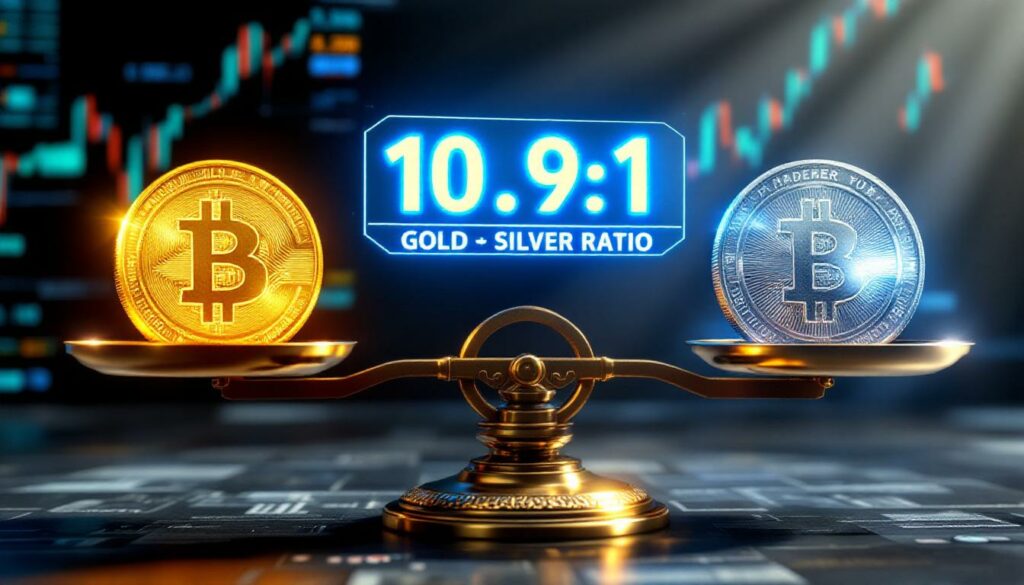Understanding the Gold to Silver Ratio: A Strategic Investment Metric
The gold to silver ratio stands as one of the oldest and most enduring metrics in precious metals investing. This powerful analytical tool provides critical insights into the relative valuation of these two monetary metals and offers strategic advantages for investors seeking to optimize their precious metals portfolio.
What is the Gold to Silver Ratio?
Definition and Basic Calculation
The gold to silver ratio represents how many ounces of silver it takes to purchase one ounce of gold. This fundamental metric is calculated by dividing the current gold price by the silver price.
For example, with gold trading at $3,300 per ounce and silver at $32.40 per ounce, the ratio stands at approximately 101.9:1. This means it would take nearly 102 ounces of silver to buy a single ounce of gold at current market prices.
The formula is straightforward:
Gold-Silver Ratio = Gold Price (per oz) ÷ Silver Price (per oz)
This simple calculation provides a standardized measurement that investors can track over time to identify potential value opportunities between the two metals.
Historical Context and Significance
Both gold and silver have served as monetary metals and stores of value for thousands of years. While gold has primarily functioned as a wealth preservation asset, silver has historically played a dual role as both money and an industrial commodity.
This ratio serves as a critical indicator for precious metals investors, functioning as a barometer for the relative valuation between these two metals. Professional traders, institutional investors, and central banks monitor this relationship closely when making allocation decisions.
The significance of the ratio lies in its ability to:
- Signal potential overvaluation or undervaluation of one metal versus the other
- Provide a historical context for current market conditions
- Serve as a trigger for portfolio rebalancing strategies
- Indicate broader economic and market sentiment
As Robert Kiyosaki, author of "Rich Dad Poor Dad," noted in a recent market commentary: "The gold-silver ratio represents one of the most reliable mean-reversion opportunities in financial markets. When the ratio reaches extreme levels, it has historically presented asymmetric risk-reward setups for contrarian investors."
How Has the Gold to Silver Ratio Changed Throughout History?
Ancient and Pre-Modern Periods
The relationship between gold and silver prices has fluctuated dramatically throughout history, reflecting changing economic conditions, mining output, and monetary policies.
In ancient civilizations, the ratio was remarkably stable compared to modern markets:
- Roman Empire (27 BCE – 476 CE): Imperial authorities maintained a fixed ratio of 12:1, meaning 12 ounces of silver equaled the value of 1 ounce of gold
- Byzantine Empire (330 CE – 1453 CE): The ratio averaged approximately 14:1
- Medieval Europe (500 CE – 1500 CE): Ratios typically ranged between 9:1 and 16:1
These historical ratios demonstrate that for most of human civilization, silver was valued much more highly relative to gold than it is today.
Modern Era Fluctuations
The abandonment of the gold standard in the 1970s marked a turning point for the gold-silver ratio. Since that watershed moment in monetary history, the ratio has experienced increased volatility and a structural shift higher:
- 1970s Average: 40:1
- 1980s-1990s Average: 65:1
- 2000-2020 Average: 68:1
- COVID-19 Pandemic Peak (March 2020): 125:1
This unprecedented spike during the COVID-19 pandemic occurred as investors flocked to gold as a premier safe-haven asset while silver's industrial demand was temporarily crushed by global economic shutdowns. This created the widest divergence between the two metals in recorded history.
Current Market Position
Today's ratio of approximately 101.9:1 sits significantly above the long-term average, suggesting a potential historical anomaly in the relative valuation of these metals. This elevated ratio indicates one of two possibilities:
- Gold has become structurally overvalued relative to silver
- Silver has become structurally undervalued relative to gold
Most precious metals analysts suggest the latter interpretation is more likely given silver's increasing industrial applications in green energy technologies and electronics.
Why Does the Gold to Silver Ratio Matter to Investors?
Market Sentiment Indicator
The ratio provides valuable insights into market sentiment and potential investment opportunities. During periods of economic uncertainty and market stress, investors typically favor gold over silver, driving the ratio higher.
Conversely, during periods of economic growth and industrial expansion, silver often outperforms gold due to its widespread industrial applications, pushing the ratio lower.
This relationship makes the gold-silver ratio an effective barometer for:
- Risk appetite: Low ratios suggest risk-on sentiment; high ratios suggest risk-off sentiment
- Economic outlook: Rising ratios often correlate with economic slowdowns; falling ratios with expansion
- Inflation expectations: Dramatic shifts in the ratio can signal changing inflation outlooks
Professional traders and institutional investors closely monitor this metric to inform their precious metals allocation strategies and broader market positioning.
Valuation Signal
A ratio substantially higher than historical averages may signal that silver is undervalued relative to gold, potentially representing a buying opportunity for silver. Consider these historical precedents:
- March 2020: Ratio peaked at 125:1, followed by silver rallying from $12 to $30 within months
- 1991: Ratio reached 100:1, followed by silver doubling in price over the next three years
- 1980: Ratio bottomed at 15:1 after silver's parabolic rise, signaling a major top in silver prices
These examples demonstrate how the ratio can serve as a powerful contrarian indicator at extremes. With the current ratio at 101.9:1 compared to the modern average of 65:1, many analysts view silver as potentially undervalued from a historical perspective.
Portfolio Rebalancing Tool
Many investors use the ratio as a trigger for rebalancing their precious metals holdings. This strategy typically involves:
- Setting ratio thresholds based on historical averages (e.g., above 80:1 or below 50:1)
- Converting a portion of gold holdings to silver when the ratio is abnormally high
- Converting a portion of silver holdings to gold when the ratio is abnormally low
This disciplined approach allows investors to systematically "buy low, sell high" between the two metals, potentially enhancing long-term returns without having to correctly predict absolute price movements.
As precious metals strategist David Morgan explains: "The ratio provides a framework for value investors to systematically rotate between metals based on relative rather than absolute valuations. This removes much of the emotion from the investment process."
How Do Traders Use the Gold-Silver Ratio in Practice?
Ratio Trading Strategies
Professional traders often employ sophisticated hedging strategies based on the gold-silver ratio. The typical approach involves:
- Pair trading: Going long on one metal while simultaneously shorting the other
- Spread trading: Using futures contracts to capture the changing relationship between metals
- Options strategies: Utilizing calls and puts to profit from changing ratios with defined risk
These approaches create market-neutral positions that profit from changes in the ratio rather than absolute price movements in either metal. This hedges against broader market risks while focusing on the specific relationship between gold and silver.
For example, when the ratio is extremely high (as it is now at 101.9:1), a trader might:
- Buy 100 ounces of silver at $32.40 ($3,240 total)
- Short 1 ounce of gold at $3,300 ($3,300 total)
If the ratio subsequently falls to 80:1 through silver outperforming gold, the trader would profit regardless of whether both metals rose or fell in absolute terms.
Mean Reversion Plays
The concept of mean reversion—the tendency for a measure to return to its long-term average over time—underlies many ratio trading strategies. When the ratio reaches extreme levels, traders may initiate positions based on the expectation that the ratio will eventually normalize.
Historical evidence supports this approach:
| Period | Starting Ratio | Ending Ratio | Duration of Reversion | Silver Performance vs. Gold |
|---|---|---|---|---|
| 1991-1993 | 100:1 | 65:1 | 24 months | +53% |
| 2003-2006 | 80:1 | 45:1 | 36 months | +78% |
| 2020-2021 | 125:1 | 65:1 | 14 months | +92% |
These historical instances demonstrate that significant mean reversion events have consistently presented profitable opportunities for ratio-based strategies, particularly favoring silver when starting from elevated ratio levels.
Timing Entry and Exit Points
The ratio can help investors optimize their entry and exit points in precious metals markets. Many traders follow these general guidelines:
- Buy silver/sell gold when the ratio exceeds 80:1 (current situation at 101.9:1)
- Hold equal allocations when the ratio is between 50:1 and 80:1
- Buy gold/sell silver when the ratio falls below 50:1
This framework provides objective triggers for portfolio adjustments rather than relying on gold price forecast or market timing.
"The gold-silver ratio gives investors a systematic method to rotate between metals without having to be precisely right about absolute price directions—a notoriously difficult task in commodity markets." — Jim Rickards, author of "The New Case for Gold"
What Factors Influence Changes in the Gold-Silver Ratio?
Economic Conditions
Economic cycles have a profound impact on the gold-silver ratio due to the different primary use cases for each metal:
- Economic contraction: During recessions and financial crises, gold typically outperforms silver as investors seek safety, driving the ratio higher
- Economic expansion: During growth periods, silver often outperforms gold due to increased industrial demand, driving the ratio lower
This cyclical pattern makes the ratio a potentially useful economic indicator. The ratio's current elevated level at 101.9:1 suggests significant economic uncertainty despite headline GDP growth, possibly reflecting concerns about inflation, geopolitical tensions, or financial system stability.
Industrial Demand Dynamics
Unlike gold, which has minimal industrial applications, silver plays a critical role in numerous growing technologies:
- Solar panels: Each solar panel contains approximately 20 grams of silver
- Electric vehicles: The average EV uses about 25-50 grams of silver in various components
- Electronics: Nearly every electronic device contains silver for conductivity
- Medical applications: Silver's antimicrobial properties make it valuable in healthcare settings
The World Silver Institute reports that industrial applications now account for more than 50% of annual silver demand. This industrial component creates demand drivers for silver that don't exist for gold, potentially influencing the ratio during technological transition periods.
The rapid growth of green energy technologies represents a particularly significant factor for future ratio movements. Solar photovoltaic installations are projected to triple by 2030, potentially requiring over 100 million ounces of additional silver annually.
Mining Production Trends
Changes in the relative production of gold and silver can influence their price relationship over time:
- Silver byproduct dynamics: Approximately 70% of silver production comes as a byproduct of mining other metals (lead, zinc, copper)
- Primary silver mines: Only 30% of silver comes from primary silver mining operations
- Gold-focused mining: Nearly all gold production comes from primary gold mines
This production relationship creates an interesting dynamic: when base metal prices fall, silver supply often declines even if silver prices remain stable, as mining companies reduce production of the primary metals that yield silver as a byproduct.
Current geological surveys suggest that accessible silver reserves are declining more rapidly than gold reserves, with the U.S. Geological Survey estimating the current silver-to-gold reserves ratio at approximately 7:1, far below the current price ratio of 101.9:1.
How Can Investors Apply the Gold-Silver Ratio Today?
Current Market Analysis
With the current ratio standing at approximately 101.9:1, well above the long-term average of 65:1, several strategic implications emerge for investors:
- Silver appears historically undervalued relative to gold based on the ratio's long-term average
- Mean reversion potential suggests possible silver market squeeze in the medium term
- Risk-reward profile favors silver allocations over gold at current relative valuations
Technical analysts note that the ratio has formed a potential double top formation near the 120:1 level, with the 2020 pandemic peak and a secondary peak in 2023. This pattern often precedes significant mean reversion moves.
Portfolio Allocation Considerations
Investors might consider implementing the following strategies based on the current elevated ratio:
- Increase silver allocation: For those underweight precious metals, emphasize silver over gold for new positions
- Rebalance existing holdings: Consider converting a portion of gold holdings to silver
- Implement dollar-cost averaging: Systematically acquire silver at regular intervals to benefit from potential ratio normalization
A balanced approach might involve allocating 70% of precious metals holdings to silver and 30% to gold until the ratio normalizes closer to historical averages.
Risk Management Framework
While the historical case for silver at current ratio levels is compelling, prudent risk management remains essential:
- Position sizing: Limit exposure to any single metal to a reasonable percentage of your portfolio
- Time horizon alignment: Ratio normalization can take months or years; ensure your time horizon matches this potential duration
- Correlation awareness: During severe market stress, gold and silver can become highly correlated despite ratio differences
- Stop-loss consideration: Consider predetermined exit points if the ratio continues to expand rather than contract
Investors should also recognize that historical patterns, while instructive, don't guarantee future performance. The structural factors affecting the gold to silver ratio continue to evolve with changes in monetary policy, industrial applications, and mining technologies.
FAQ: Common Questions About the Gold-Silver Ratio
What is considered a "normal" gold-silver ratio?
While the ratio has varied significantly throughout history, different eras have established different norms:
- Ancient world through 19th century: 12:1 to 15:1
- Gold standard era (1870s-1930s): 15:1 to 30:1
- Post-gold standard era (1971-present): 65:1 average
The modern average since the 1970s has been approximately 65:1, though market conditions can drive substantial deviations from this mean. Many analysts consider ratios above 80:1 as historically elevated and ratios below 50:1 as historically low in the modern context.
Does a high ratio always mean silver will outperform gold?
While a historically high ratio suggests silver may be undervalued relative to gold, there's no guarantee of immediate mean reversion. Several factors can maintain an elevated ratio:
- Prolonged economic uncertainty may sustain gold market surge
- Structural changes in industrial demand could alter historical relationships
- Central bank policies favoring gold over silver can influence institutional flows
Historical data shows that ratio extremes have typically preceded significant mean reversion, but the timing remains unpredictable. Investors should view the ratio as a valuable indicator rather than a precise timing tool.
How quickly does the ratio typically revert to its mean?
Mean reversion timeframes vary considerably based on market conditions:
- Rapid reversions (3-6 months): Often occur following financial crises when extreme fear subsides
- Moderate reversions (1-2 years): Most common historical pattern
- Extended reversions (3+ years): Can occur during structural economic shifts
The 2020 pandemic spike to 125:1 reverted halfway to the mean within approximately 5 months, demonstrating that extreme readings can correct relatively quickly under certain conditions.
Where can investors monitor the current gold-silver ratio?
Investors can track the live gold-silver ratio through several reliable sources:
- Financial data providers: Bloomberg Terminal, Reuters Eikon
- Precious metals websites: Kitco.com, APMEX.com
- Brokerage platforms: Most major trading platforms include the ratio as a custom indicator
Many of these sources also provide historical ratio charts and technical analysis tools to help investors identify trends and potential reversal points.
Conclusion: Strategic Implications for Investors
The gold-silver ratio represents a powerful analytical tool for precious metals investors, offering insights into relative valuations and potential market opportunities. With the current ratio significantly above historical averages at 101.9:1, investors may find strategic value in understanding this relationship when constructing their precious metals portfolio.
Historical precedent suggests that extreme ratio readings have typically presented advantageous entry points for the undervalued metal—currently silver based on historical comparisons. However, investors should approach ratio-based strategies with realistic expectations regarding timeframes and potential outcomes.
For those considering implementing ratio-based strategies:
- Start small: Begin with a modest allocation to test the strategy
- Maintain discipline: Establish clear ratio thresholds for entries and exits
- Document decisions: Keep records of ratio levels at transaction points
- Extend time horizons: Allow sufficient time for potential mean reversion
- Review regularly: Reassess the strategy as [gold price highs analysis](https://discoveryalert.com.au/news/gol
Want to Discover the Next Major Mineral Opportunity?
Stay ahead of the market with Discovery Alert's proprietary Discovery IQ model, delivering real-time notifications on significant ASX mineral discoveries that could generate substantial returns. Explore historic examples of exceptional investment outcomes by visiting the Discovery Alert discoveries page and begin your 30-day free trial today.




